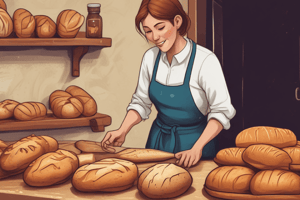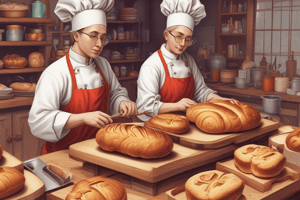Podcast
Questions and Answers
What is the primary reason for scaling ingredients in bread making?
What is the primary reason for scaling ingredients in bread making?
- To control the cost of production
- To ensure accurate calculation of the final dough yield (correct)
- To achieve a consistent dough temperature
- To mix ingredients uniformly
Why is measuring ingredients by weight necessary in bread making?
Why is measuring ingredients by weight necessary in bread making?
- To achieve uniform distribution of ingredients
- To ensure a consistent dough temperature
- To ensure accuracy and precision (correct)
- To prevent over- or underproduction
What is the significance of calculating the water temperature in bread making?
What is the significance of calculating the water temperature in bread making?
- It helps to achieve a desired dough temperature (correct)
- It enables the mixing of ingredients uniformly
- It helps to achieve a consistent dough yield
- It ensures the correct alignment of gluten molecules
What is the primary outcome of mixing ingredients in bread making?
What is the primary outcome of mixing ingredients in bread making?
What happens to the gluten molecules during the mixing process?
What happens to the gluten molecules during the mixing process?
What is the significance of developing dough strength in bread making?
What is the significance of developing dough strength in bread making?
Why is it important to use a reliable scale in bread making?
Why is it important to use a reliable scale in bread making?
What is the outcome of under- or overproduction in bread making?
What is the outcome of under- or overproduction in bread making?
What is the primary purpose of scoring bread?
What is the primary purpose of scoring bread?
What happens to weak breads when they are deeply scored?
What happens to weak breads when they are deeply scored?
What is a characteristic of breads that can handle vigorous scoring?
What is a characteristic of breads that can handle vigorous scoring?
Why might a baker use light scoring on certain breads?
Why might a baker use light scoring on certain breads?
What is the effect of deep scoring on breads that are already weak?
What is the effect of deep scoring on breads that are already weak?
What is the relationship between a bread's strength and its ability to handle scoring?
What is the relationship between a bread's strength and its ability to handle scoring?
Why does the author avoid placing preshaped loaves seams down on the work surface?
Why does the author avoid placing preshaped loaves seams down on the work surface?
What is the primary goal of the final fermentation phase?
What is the primary goal of the final fermentation phase?
What is the purpose of scoring the bread before baking?
What is the purpose of scoring the bread before baking?
Why does the author recommend covering the loaves during the bench rest?
Why does the author recommend covering the loaves during the bench rest?
What is the ideal degree of rise for bread before baking?
What is the ideal degree of rise for bread before baking?
What is the purpose of the preshaping step?
What is the purpose of the preshaping step?
Why does the author avoid overproofing the bread?
Why does the author avoid overproofing the bread?
What is the primary factor that determines the duration of the bench rest?
What is the primary factor that determines the duration of the bench rest?
What is the purpose of using a razor or other blade to score the bread?
What is the purpose of using a razor or other blade to score the bread?
Why does the author use plastic or vinyl covers to cover the loaves during the bench rest?
Why does the author use plastic or vinyl covers to cover the loaves during the bench rest?
What is the primary purpose of adequately developing gluten in the dough?
What is the primary purpose of adequately developing gluten in the dough?
What is the main advantage of using mechanical dividers over hand dividing?
What is the main advantage of using mechanical dividers over hand dividing?
Why is it important to dust the plate of the scale and the hands with flour during hand dividing?
Why is it important to dust the plate of the scale and the hands with flour during hand dividing?
What is the primary purpose of preshaping the dough?
What is the primary purpose of preshaping the dough?
What determines when the final shaping can occur after preshaping?
What determines when the final shaping can occur after preshaping?
Why is it beneficial to place the preshaped loaves on a floured work surface or floured bread boards?
Why is it beneficial to place the preshaped loaves on a floured work surface or floured bread boards?
What is the advantage of placing the preshaped loaves in an orderly fashion on the work surface?
What is the advantage of placing the preshaped loaves in an orderly fashion on the work surface?
Why do some bakers prefer to place the preshaped loaves with the seams down?
Why do some bakers prefer to place the preshaped loaves with the seams down?
What is the potential disadvantage of using hydraulic dough dividers?
What is the potential disadvantage of using hydraulic dough dividers?
Why is it important to avoid having a dough piece that consists of lots of little chunks of dough?
Why is it important to avoid having a dough piece that consists of lots of little chunks of dough?
Flashcards are hidden until you start studying
Study Notes
Step 1: Scaling
- The first step in bread making is scaling, which involves measuring ingredients accurately to ensure consistency and uniformity of production.
- Measuring ingredients by weight is the only way to ensure accuracy, and a reliable scale is essential for every baker.
- Accurate scaling prevents under- or overproduction and aids in cost control.
Step 2: Mixing
- The first step in proper mixing involves determining the correct water temperature required for the mix.
- Consistent baking results require consistent temperature control, which is achieved by calculating the desired dough temperature.
- Mixing brings about a uniform distribution of ingredients, forms gluten, and enables the dough to stretch well, resist ripping, and hold trapped carbon dioxide gases.
Step 5: Dividing
- Bulk fermentation ends when the dough is divided, and there are various mechanical and hand-dividing methods.
- Mechanical dividing is speedier but may drive out fermentation gas, while hand dividing is gentler and may result in better bread quality.
- Speed is important when dividing to avoid overaging the dough, and dusting the plate and hands with flour helps keep things dry and smooth.
Step 6: Preshaping
- Once divided, the dough is preshaped to change its random shape into a more consistent shape.
- Preshaping organizes the dough, making final shaping easier and more effective.
- A light or strong preshaping can be used to bring an extra dose of strength to weak doughs, and the tightness of preshaping determines when final shaping can occur.
Step 7: Bench Rest
- This passive step allows the dough to relax and is directly determined by how loosely or tightly the loaves have been preshaped.
- The preshaped loaves are covered with a sheet of plastic or vinyl to prevent a surface crust from forming.
Step 8: Shaping
- The baker takes the preshaped loaves and gives them a final shape, which can be round, oblong, baguette-shaped, or other variations.
- Once shaped, the loaves go into bannetons, between folds of baker's linen, or into metal loaf pans or onto sheet pans, and are covered to prevent dehydration.
Step 9: Final Fermentation
- Final fermentation (final proofing) is the phase between shaping and loading the loaves into the oven.
- The major goal of final fermentation is to raise the bread to the desired degree, usually around 85 to 90 percent risen.
- Over- or under-risen bread can affect its eating quality and visual aspect.
Step 10: Scoring
- Scoring involves intentionally creating a weak section on the surface of the loaf to encourage controlled expansion during baking.
- Some breads, like braided loaves, ciabattas, and fendu-shaped loaves, go into the oven with no scoring, while others require scoring to achieve the desired shape.
- Different scoring methods can greatly impact the appearance and quality of the bread.
Step 11: Baking
- The final step involves baking the scored loaves in the oven, where they expand and take on their final shape.
- The baking process requires careful temperature control to achieve the desired crust and crumb.
Studying That Suits You
Use AI to generate personalized quizzes and flashcards to suit your learning preferences.




